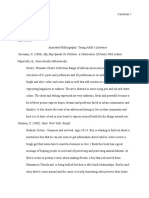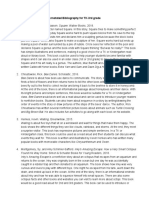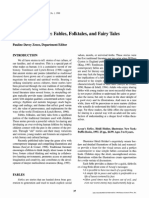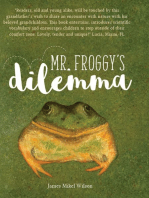Elsa Cardenas Professor Lancaster LIS 527 June 24, 2016 Annotated Bibliography: Children's Literature
Elsa Cardenas Professor Lancaster LIS 527 June 24, 2016 Annotated Bibliography: Children's Literature
Uploaded by
api-266892891Copyright:
Available Formats
Elsa Cardenas Professor Lancaster LIS 527 June 24, 2016 Annotated Bibliography: Children's Literature
Elsa Cardenas Professor Lancaster LIS 527 June 24, 2016 Annotated Bibliography: Children's Literature
Uploaded by
api-266892891Original Title
Copyright
Available Formats
Share this document
Did you find this document useful?
Is this content inappropriate?
Copyright:
Available Formats
Elsa Cardenas Professor Lancaster LIS 527 June 24, 2016 Annotated Bibliography: Children's Literature
Elsa Cardenas Professor Lancaster LIS 527 June 24, 2016 Annotated Bibliography: Children's Literature
Uploaded by
api-266892891Copyright:
Available Formats
Cardenas 1
Elsa Cardenas
Professor Lancaster
LIS 527
June 24, 2016
Annotated Bibliography: Childrens Literature
Aardema, V. (1975). Illus. Dillon, L., & Dillon, D. Why mosquitoes buzz in people's ears: A West
African tale. New York: Dial Press.
Traditional Literature. Ages 5-7. An African inspired story that begins with a mosquito
buzzing in an iguanas ear but the iguana has no time for such foolish talk and he puts
sticks in his ears. Snake is afraid that iguana has a scheme going on and jumps into a hole
that scares rabbit which starts series of alarming events with the animals thinking they're
in danger. This brings disaster to mother owl and the sun no longer comes out. The story
and illustrations are full of vibrant colors and African Inspired abstract art. The length of
the text is great for children with some tongue twister that make you think you are talking
African. There also lies a moral to the story that you must be responsible for your actions.
Curtis, C. P. (2007). Elijah of Buxton. New York: Scholastic Press.
Historical Fiction - The Development of Industrial Society, 1800 to 1914. Ages 11-14.
Elijah is a 11 year old boy that is one of the first black babies to be born free in Canada.
As Elijah develops and becomes older he does not stop being scared of snakes and
always fragile about everything. One day his fragile state all changes when he is forced to
defend his friend and help him recuperate the money that was stolen from him to buy his
parents out of slavery. Elijah always lived a comfortable life but he soon came to realize
that there is another life that his parents had to go through that leaves him in shock of all
the horrors blacks have to go through. This is a great story to read to the students during
Black History Month and the civil war unit.
Floca, B. (2009). Moonshot: The flight of Apollo 11. New York: Atheneum Books for Young
Readers.
Informational Nonfiction - Physical Science. Ages 6-9 The author goes step by step
explaining how the astronauts prepare for lift off to the shuttle, how the control room
prepares for lift off, how American families were excited and the final moments to lift
out. The colorful cartoon, pen and ink illustrations keep the reader wanting more visual
Cardenas 2
images about what it was like to be in a rocket shuttle, walk on the moon and return
home. It includes some big text and medium text that does not overwhelm the read on
each page which gives it an easy style.
Katz, B., & (2004). Pocket poems. Illus. Hafner, M. New York: Dutton Children's Books.
Specialized Poetry Books. Ages 5-8. The book contains great watercolor and pen
illustrations used to describe each poem. It contains a context page and has 2-3 poems per
page. All are short poems that are great to use for National Poetry Month and Poem in a
Pocket. It contains a collection of well known poets and even a bilingual poem. These
great rhythmic poems express the world through a child's perspective at school, weather,
adventurous and home. Children and adults will love to read these humorous poems and
relate to each of them.
Khan, R.(2010). Illus. Blackall, S. Big red lollipop. New York: Viking.
Realistic Fiction - Families. Ages 4-8.
Lin, G. (2006). The year of the dog: A novel. New York: Little, Brown.
Diverse Society - Asian/Pacific-American Literature. Ages 8-11. The book explains many
Chinese traditions in the perspective of a young Taiwanese-American girl. Its the year of
the dog and that means its time for Grace to think about what she is talented in but she is
not sure. This is a great novel for young girls to relate to about school projects, family,
having a crush and making great memories with your best friend. It also gives visual hand
drawn illustrations of what some chinese object or events look like as well as how the
family speaks in Chinese, Taiwanese and English.
Martin, B., & Archambault, J. (1989). Illus. Ehlert, L. Chicka Chicka Boom Boom. Simon &
Schuster.
Alphabet Picture Book. Ages 3-6. With colorful illustrations for each letter of the
alphabet that captivate the reader in wanting to find out what will happen next to each
letter. Three pairs of letters want to make it to the top of the coconut tree but the coconut
tree is not big enough for all the letters and can not sustain them all. Eventually all the
lowercase baby letters fall and the upper case parent letters come and help them back up.
The story plays with rhyming and gives each letter a special personality. This is an all
time favorite to learn the ABCs in a humorous way.
Mass, W. (2009). 11 birthdays. New York: Scholastic Press.
Modern Fantasy: Supernatural Events and Mystery Fantasy. Ages 9-12. Two best friends
are born on the same day and end up sharing each birthday party together expect for their
Cardenas 3
11th birthday. On their 10th birthday Amanda overhear her best friend Leo talking to his
guy friends and she is disappointed and that was the end of their friendship. When their
11th birthday comes around and it's time for them to celebrate birthdays separate Amanda
can not get out of this so called dream that seems to repeat itself until she begins to make
changes in her routine.
Myers, W. D. (2010). The Cruisers. New York: Scholastic Press.
Diverse Society - African American Literature. Ages 10-14. Great book for reluctant
readers. It is very relatable to what 8th graders would go through especially if you a
minority student. A group of Gifted and Talented friends from the lower parts of town are
given an opportunity to go to a great school Da Vinci Academy in Harlem but they soon
find themselves on the verge of becoming expelled if they do not straighten up. They are
given a chance to participate in a school project and be peacemakers during the civil war
but they end up creating their own war on the campus against the blacks and the whites.
The Cruisers are the friends newspaper on campus and they begin to publish articles that
begin to shake up the school and community to know that freedom of speech is not
always right.
Rex, A. (2006). Frankenstein makes a sandwich: And other stories you're sure to like, because
they're all about monsters, and some of them are also about food... Florida: Harcourt.
Specialized Poetry Books. Ages 9-12. These are great classical characters that tell a story
fit for a humours child of this time. Who doesn't want to see the softer side of
Frankenstein, Dracula, Bigfoot, The Phantom of the Opera and Witches. Theses funny
versions of the new and improved scarey monsters allow the children to see that as
interesting monster either looking for food or escaping It's a small world after all.
The illustrations are full of graceful strokes of water colors and rhythmic funny rhythms.
There are also small message in the background that you will not want to put the book
down until you have read everything.
Ryan, P. M.(2010). Illus. Sis, P. The dreamer. New York: Scholastic Press.
Biography. Ages 9-14. This is a beautiful story that demonstrate the harshness of society
and even one's family.This fictional biography of Pablo Neruda that talks about a boy
Naftali whose father is not to kind to him and is very strict. His father is not pleased that
his son likes to daydream and he is sure to put a stop to it. This story has a serious tone
and will tug a the heat because you want to leave the dreams with Neftali. Ryan does a
great job at playing with words and bring the pages to life with the pen illustrations. This
Cardenas 4
book is not for every young person because they may not be able to keep up with the tone
of the story but it sure will make you reflect on the harshness that many unknown
children have to go through.
Simon, S. (2005). Guts: Our digestive system. New York, NY: HarperCollins.
Informational Nonfiction - Biological Science. Ages 9-14. Children may often wonder
how exactly their digestive system works and this books offers curious minds a glimpse
as to what they can not see but what they can feel and hear move within them. The text is
big and contains x-ray photographs and microscopic photographs as to what the digestive
system looks like and the different parts involved. It also explains and demonstrates the
stages that food goes through and how it is broken down. I like the fact that it gives
advice on who to talk to about nutrition and if you feel your body not acting right. After
reading and seeing the images the readers is left with wanting to know more about their
other body parts.
Slater, D. (2006). Baby shoes. Illus. Nakata, H. New York: Bloomsbury Children's Books.
Interactive Picture Book. Ages 1-3. After mama buys baby their first pair of white shoes
baby goes around town on an adventure with colorful objects that add a new color each
time to his shoes. This is a great book for babies and toddlers to show them all the great
things they can do with a pair of shoes. When baby says Uh-Oh! mama says Oh-No!
but that does not stop baby and mama from having a good time around town. Great
illustrations with watercolors demonstrating the joys of exploring and creating rhythms
that toddlers will love to repeat.
Smith, L. (2011). Grandpa Green. New York: Roaring Brook Press.
Picture Book. Ages 8-11. Grades K-3. A trip down memory lane is always good for the
soul and to know the history of your family. The great grandson of Grandpa Green begins
to explore his grandfather's garden and tells a story of his childhood, adolescence and
adulthood. Grandpas garden is able to remember many memories that grandpa may
forget. This is a touching beautiful story and illustrations of what keeping up a beautiful
garden can demonstrate throughout the generations of lush and lavish greens, bushes and
imagination can create. Children will spend more time looking at all the beautiful pages
of illustration after reading.
Weeks, S. (2004). So B. It: A novel. New York: Laura Geringer Books.
Realistic Fiction - Physical, Emotional, Mental and Behavioral Challenges. Ages 10-14.
Cardenas 5
At a week of being born Heidi finds herself in her mother's arms and at the front steps of
a stranger. With time Heidi realizes that her mother is mentally ill and the lady Bernadette
that took them in is agoraphobic. Heidis mom only knows 23 words and can not tell their
neighbor Bernadette or Heidi anything about who they are or where they come from
which leaves Heidi in need of finish answers. She finds old photos and is determined to
know who her father and family are and goes on a adventure to find the truth. Weeks does
a great job at express the challenges a family goes through with a loved one who is
mentally ill and how it affects an adolescent growing up.
You might also like
- Annotated BibliographyDocument5 pagesAnnotated Bibliographyapi-548303973No ratings yet
- Cardenas 1Document5 pagesCardenas 1api-266892891No ratings yet
- Cardenas 1Document5 pagesCardenas 1api-266892891No ratings yet
- Welding SopDocument6 pagesWelding SopRuban George100% (1)
- The Beautiful Lost (Excerpt)Document21 pagesThe Beautiful Lost (Excerpt)I Read YA75% (4)
- Square: Annotated Bibliography For TK-3rd GradeDocument4 pagesSquare: Annotated Bibliography For TK-3rd Gradeapi-483896389No ratings yet
- Annotated BibliographyDocument9 pagesAnnotated Bibliographyapi-251336193No ratings yet
- Classroom Library Wish List BraveryDocument10 pagesClassroom Library Wish List Braveryapi-297259056No ratings yet
- Boys and Girls Forever: Children's Classics from Cinderella to Harry PotterFrom EverandBoys and Girls Forever: Children's Classics from Cinderella to Harry PotterRating: 3.5 out of 5 stars3.5/5 (26)
- Kei78569 ch03Document42 pagesKei78569 ch03Aura MateiuNo ratings yet
- Interamerican University of Puerto Rico Metro Campus School of EducationDocument11 pagesInteramerican University of Puerto Rico Metro Campus School of EducationJannette HernandezNo ratings yet
- Fables Folktales and FairytalesDocument5 pagesFables Folktales and Fairytalesapi-262786958No ratings yet
- CCBC Presentation Notes - 2010Document8 pagesCCBC Presentation Notes - 2010jamzak305129No ratings yet
- LECTURE1Document9 pagesLECTURE1Chriza Mae DandoNo ratings yet
- Children's Library Resources Log Junior Novel /chapter Book Category (Grades 3 - 6 or 5 - 8) - Five BooksDocument14 pagesChildren's Library Resources Log Junior Novel /chapter Book Category (Grades 3 - 6 or 5 - 8) - Five Booksapi-257776672No ratings yet
- Module 9 - Cirg 653Document6 pagesModule 9 - Cirg 653api-548199752No ratings yet
- Annotated Bibliography of BooksDocument8 pagesAnnotated Bibliography of Booksapi-664731680No ratings yet
- For PortfolioDocument5 pagesFor Portfolioapi-307668382No ratings yet
- Andybrenn Children's and Adolescent Library Resources LogDocument13 pagesAndybrenn Children's and Adolescent Library Resources Logapi-272764454No ratings yet
- ChildsBkList TSCCDocument64 pagesChildsBkList TSCCStella CobbNo ratings yet
- Grade Level: 1.3 Interest Level: Ages 6-8Document11 pagesGrade Level: 1.3 Interest Level: Ages 6-8api-283017402No ratings yet
- Culturally Responsive Library FinalDocument25 pagesCulturally Responsive Library Finalapi-249065363No ratings yet
- Children's LitDocument88 pagesChildren's LitO'ma MoncadaNo ratings yet
- Annotated Bibliography:: Children's Picture Books and NovelsDocument9 pagesAnnotated Bibliography:: Children's Picture Books and NovelsYunki MinNo ratings yet
- Final Text SetDocument13 pagesFinal Text Setapi-316425759No ratings yet
- Immedium 2011 Children's Book CatalogDocument27 pagesImmedium 2011 Children's Book CatalogImmediumNo ratings yet
- Children's and Adolescent Library Resources LogDocument23 pagesChildren's and Adolescent Library Resources Logapi-184833338No ratings yet
- Angeirimmannotated Bibliography 2013Document13 pagesAngeirimmannotated Bibliography 2013api-227636227No ratings yet
- Dana AnnotatedbibDocument12 pagesDana Annotatedbibapi-227636227No ratings yet
- Lib510 Annotated Bibliography of Childrens BooksDocument9 pagesLib510 Annotated Bibliography of Childrens Booksapi-277628554No ratings yet
- GenreDocument6 pagesGenreapi-319687280No ratings yet
- Diversity Text SetDocument3 pagesDiversity Text Setapi-439133207No ratings yet
- Book Summaries 3-ADocument10 pagesBook Summaries 3-Aapi-297509236No ratings yet
- Annotated BibliographyDocument9 pagesAnnotated Bibliographyapi-534408850No ratings yet
- Engl 414 Annotated BibliographyDocument14 pagesEngl 414 Annotated Bibliographyapi-252923469No ratings yet
- EED 15 Module 1Document59 pagesEED 15 Module 1niroannabellaNo ratings yet
- Engl 414 11 13 Annotated BibDocument13 pagesEngl 414 11 13 Annotated Bibapi-268930392No ratings yet
- Khaoi Mady Collection DevelopmentDocument5 pagesKhaoi Mady Collection Developmentapi-241823296100% (1)
- Annotated BibliographyDocument12 pagesAnnotated Bibliographyapi-253911034No ratings yet
- Childrens Lit Biblio Re Revised FinalDocument13 pagesChildrens Lit Biblio Re Revised Finalapi-250420087No ratings yet
- Annotated BibliographyDocument14 pagesAnnotated Bibliographyapi-403767613No ratings yet
- Book Analysis ProjectDocument10 pagesBook Analysis Projectapi-176583384No ratings yet
- Mary H. McNulty, "Postmodernism in Children's Books"Document2 pagesMary H. McNulty, "Postmodernism in Children's Books"PACNo ratings yet
- Book Analysis Project RevisedDocument10 pagesBook Analysis Project Revisedapi-272455413No ratings yet
- Annotated Bibliography Children Lit CastleDocument10 pagesAnnotated Bibliography Children Lit Castleapi-302656208No ratings yet
- Todays AdventureDocument32 pagesTodays Adventureapi-560504494No ratings yet
- ListDocument11 pagesListapi-317273644No ratings yet
- Whitney Completebibliography MaDocument16 pagesWhitney Completebibliography Maapi-667215134No ratings yet
- Lit Circles IntroDocument4 pagesLit Circles Introapi-229016896No ratings yet
- Childrens Literature AnalysisDocument10 pagesChildrens Literature Analysisapi-314425210No ratings yet
- Portfolio AnnotationsDocument10 pagesPortfolio AnnotationsAnonymous f1QhVxutqNNo ratings yet
- Brewer Bibliography FinalDocument34 pagesBrewer Bibliography Finalapi-290215511No ratings yet
- Libros Depresivos en LIJDocument13 pagesLibros Depresivos en LIJRoberto Cabrera ValderramaNo ratings yet
- Juliaannotated BibliographyDocument6 pagesJuliaannotated Bibliographyapi-227636227No ratings yet
- Annotated BibliographyDocument13 pagesAnnotated Bibliographyapi-242189609No ratings yet
- Children Literature 1Document10 pagesChildren Literature 1milanesasNo ratings yet
- Children's BookDocument20 pagesChildren's BookMaryamAmiri100% (1)
- Elem. Summer-Reading 2011Document23 pagesElem. Summer-Reading 2011gcimorelliNo ratings yet
- Tech-Set Annotated BibliographyDocument10 pagesTech-Set Annotated Bibliographyapi-253425240No ratings yet
- CitationDocument9 pagesCitationapi-266892891No ratings yet
- Cardenasweek 4 AssignmentDocument1 pageCardenasweek 4 Assignmentapi-266892891No ratings yet
- Glasgow, Neal A.: Black HatDocument3 pagesGlasgow, Neal A.: Black Hatapi-266892891No ratings yet
- Floor Plan 2016 Barton LibraryDocument1 pageFloor Plan 2016 Barton Libraryapi-266892891No ratings yet
- Capstone Final Project Team 3Document15 pagesCapstone Final Project Team 3api-266892891No ratings yet
- IhearpptDocument23 pagesIhearpptapi-266892891No ratings yet
- Innoactivity 2Document4 pagesInnoactivity 2api-266892891No ratings yet
- Campus2006chart 1 1Document1 pageCampus2006chart 1 1api-266892891No ratings yet
- DR D E-PortfoliosDocument8 pagesDR D E-Portfoliosapi-266892891No ratings yet
- Phototherapy - Theses Dissertations As of June - 2020 2 PDFDocument15 pagesPhototherapy - Theses Dissertations As of June - 2020 2 PDFZsuzsaNo ratings yet
- Smart Banking SolutionDocument15 pagesSmart Banking Solutionfreddysh4330No ratings yet
- Tactical World - Spring 2014 USADocument132 pagesTactical World - Spring 2014 USAPaul Hutchinson100% (4)
- Writing Weird FictionDocument13 pagesWriting Weird FictionLeonel Urbina100% (1)
- IntroductiontoMicros PDFDocument74 pagesIntroductiontoMicros PDFFakhri KANo ratings yet
- Structure and Narration in The Great GatsbyDocument4 pagesStructure and Narration in The Great GatsbycyaanideNo ratings yet
- .Au Docs Downloads Tevicom Brochures Product Range Files Tevicom Brochure PDFDocument11 pages.Au Docs Downloads Tevicom Brochures Product Range Files Tevicom Brochure PDFvijayakumarNo ratings yet
- Britney Spears - ToxicDocument26 pagesBritney Spears - ToxicEllie BuchanNo ratings yet
- Utilize Electronic Media 2 2012Document102 pagesUtilize Electronic Media 2 2012Cian GuintoNo ratings yet
- Report Palazzetto Croci SpreadsDocument73 pagesReport Palazzetto Croci SpreadsUntaru EduardNo ratings yet
- How To Choose A Basic Portrait Painting Palette For OilsDocument38 pagesHow To Choose A Basic Portrait Painting Palette For OilsAstro NautNo ratings yet
- Build Your Dream Castle and We'Ll Tell You Your Royal NameDocument1 pageBuild Your Dream Castle and We'Ll Tell You Your Royal Namemoses.sunil.lawrenceNo ratings yet
- Canon t50 ManualDocument33 pagesCanon t50 ManualjasminzheaNo ratings yet
- Narrative Writing SampleDocument2 pagesNarrative Writing SampleAsterisk KhantNo ratings yet
- 2010 - Chess Life 01Document76 pages2010 - Chess Life 01KurokreNo ratings yet
- Macherey Nagel TLCDocument45 pagesMacherey Nagel TLCRia Doloking SituruNo ratings yet
- Extravagant Designs by Luigi ColaniDocument40 pagesExtravagant Designs by Luigi ColaniBrandy Roman100% (1)
- Monotype ImagingDocument7 pagesMonotype ImagingtanitartNo ratings yet
- Supervised By:: (Problems Being Addressed ?)Document1 pageSupervised By:: (Problems Being Addressed ?)Pravat SatpathyNo ratings yet
- Canon Gp160 BrochureDocument4 pagesCanon Gp160 BrochureAlejandra SanchezNo ratings yet
- The Girl On The Train PDFDocument99 pagesThe Girl On The Train PDFHann B. FufunanNo ratings yet
- Subject: PHYSICS: Topic: Convex LensDocument29 pagesSubject: PHYSICS: Topic: Convex LensEdu 4 UNo ratings yet
- Photo BleachingDocument10 pagesPhoto BleachingAwalliantoniNo ratings yet
- Allie Spillyards ResumeDocument2 pagesAllie Spillyards ResumeAllie SpillyardsNo ratings yet
- Eigenfaces With PcaDocument12 pagesEigenfaces With Pcaapi-358127907No ratings yet
- Avant-Garde and After - Brandon Taylor - 1Document5 pagesAvant-Garde and After - Brandon Taylor - 1Jorge Santana25% (4)
- Secrets and Shadows ScreenplayDocument30 pagesSecrets and Shadows ScreenplayDenis JudillaNo ratings yet
- SitePro CatalogDocument40 pagesSitePro Catalogbbutros_317684077100% (1)


































































































